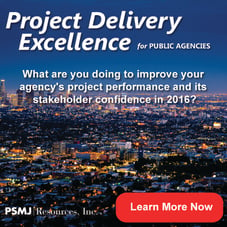 Very, very few U.S. design-for-construction organizations have any real concept of the purpose, strength, and flexibility of the international quality standard, or how to use it effectively.
Very, very few U.S. design-for-construction organizations have any real concept of the purpose, strength, and flexibility of the international quality standard, or how to use it effectively.
Consequently, I'd like to present details on what architecture/engineering (A/E) firms ought to think carefully about before launching into building a Quality Management System (QMS).
This blog post is a follow up to last week's, QC/QA Thinking: SO Last Century!, in which I discussed a Departmernt of Transportation (DOT) study of what they considered to be “innovative or standout” QC/QA programs in NY, PA, KY, MN, GA, OR, and CA, with additional input from DOTs in OH, WA and IL.
At the time of the study, only one of the DOT states had an ISO 9001:2000 program in place; Illinois. This comment came from their experience: “The ISO process may be too detailed to use on every design and does not leave room for risk-based types of review. Some projects need a closer review than others; however, the ISO process has the same requirements for all projects.”
To the eye of an experienced quality reviewer, this thinking shows clearly that the Illinois DOT’s QM system is both over-designed (too complex) and under-designed (not identifying that risk is a quality consideration and should be part of the system). Moreover, there is no requirement that all projects are treated the same; that’s a common but faulty interpretation.
This evident absence of understanding the deeper nature of ISO 9001 quality management is characteristic of most design organizations when they first get into comprehensive quality thinking: Simultaneously making it far too difficult because of slavish attention to the wording of the standard, and assuming that things that make an
industry unique are not covered by it.
For example, one of the most common mistakes people make is concluding that they need to “keep records of records,” which of course means duplication of paperwork. It’s simply not true. If the records are properly organized and identified sufficient to serve the firm in the absence of any QM system, then the records ARE the
records, and there is no excess paperwork.
What else matters, besides QA and QC?
There are about 50 sections in ISO 9001. Besides the two everybody knows about, there are three ideas you ought to think carefully about before launching into building a QMS:
1. Management responsibility: No matter how much you’d like to give this assignment to a bright staffer who loves systems, you can’t. Senior management must be involved, in planning the overall system, in reviewing performance inputs by the Quality Manager, and in directing and reviewing continual improvement.
2. Continual improvement: “If it ain’t broke, don’t fix it” doesn’t work in an ISO 9001 compliant QM system. Everything can be improved, and deciding what’s next on the list is the responsibility of top management. It’s a never-ending process. The alternative is to gradually but surely drift into irrelevance.
3. Verification: Just getting the contract documents right isn’t good enough—you have an established duty of care to be certain that what gets built is compliant with both those documents, and with all relevant codes. If you don’t believe me, read the history of the 1981 Hyatt Regency hotel bridge collapse in Kansas City.
My advice: You don’t do your own dentistry or brain surgery. Get the best helper you can find—in the end it save you a LOT of money and aggravation, and you’ll have a system that will resonate with your state DOT. Your consultant must be an architect or engineer with a deep track record in building ISO 9001 QM systems. There aren’t many.
About the Author: Charles Nelson, AIA, LFRAIA, is the Director of PSMJ’s Australasia practice. He is also known for writing and speaking extensively on project and practice management. Reach Charles at cnelson@psmj.com.
You also might be interested in these project management-related blog posts:
4 Essential Project Management Tips for A/E Professionals
How to Overcome Impediments to Effective Project Management
Project Change Management – How Other Industries Do It
Today's Top Ten Project Management Trends
Transportation Project Management
 Interested in more project management best practices? PSMJ's Project Delivery Excellence For Public Agencies focuses on simple project management approaches that achieve better results than traditional, less-effective, more time-consuming methods. This program will provide you with the tools to more efficiently manage multiple projects while controlling the schedule and budget and the changes that inevitably happen. Our project management protocols focus exclusively on
Interested in more project management best practices? PSMJ's Project Delivery Excellence For Public Agencies focuses on simple project management approaches that achieve better results than traditional, less-effective, more time-consuming methods. This program will provide you with the tools to more efficiently manage multiple projects while controlling the schedule and budget and the changes that inevitably happen. Our project management protocols focus exclusively on the public works environment and issues that specifically hit the public sector on a daily basis.


